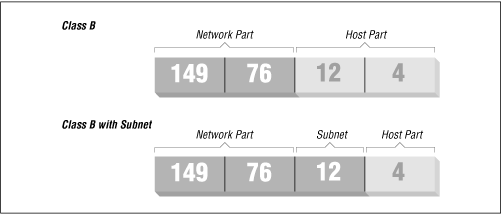Книга: Linux Network Administrator Guide, Second Edition
Subnetworks
Subnetworks
This structure is reflected by splitting IP addresses into a host and network part, as explained previously. By default, the destination network is derived from the network part of the IP address. Thus, hosts with identical IP network numbers should be found within the same network.[15]
It makes sense to offer a similar scheme inside the network, too, since it may consist of a collection of hundreds of smaller networks, with the smallest units being physical networks like Ethernets. Therefore, IP allows you to subdivide an IP network into several subnets.
A subnet takes responsibility for delivering datagrams to a certain range of IP addresses. It is an extension of the concept of splitting bit fields, as in the A, B, and C classes. However, the network part is now extended to include some bits from the host part. The number of bits that are interpreted as the subnet number is given by the so-called subnet mask, or netmask. This is a 32-bit number too, which specifies the bit mask for the network part of the IP address.
The campus network of Groucho Marx University is an example of such a network. It has a class B network number of 149.76.0.0, and its netmask is therefore 255.255.0.0.
Internally, GMU's campus network consists of several smaller networks, such various departments' LANs. So the range of IP addresses is broken up into 254 subnets, 149.76.1.0 through 149.76.254.0. For example, the department of Theoretical Physics has been assigned 149.76.12.0. The campus backbone is a network in its own right, and is given 149.76.1.0. These subnets share the same IP network number, while the third octet is used to distinguish between them. They will thus use a subnet mask of 255.255.255.0.
Figure 2.1 shows how 149.76.12.4, the address of quark, is interpreted differently when the address is taken as an ordinary class B network and when used with subnetting.
Figure 2.1: Subnetting a class B network

It is worth noting that subnetting (the technique of generating subnets) is only an internal division of the network. Subnets are generated by the network owner (or the administrators). Frequently, subnets are created to reflect existing boundaries, be they physical (between two Ethernets), administrative (between two departments), or geographical (between two locations), and authority over each subnet is delegated to some contact person. However, this structure affects only the network's internal behavior, and is completely invisible to the outside world.




